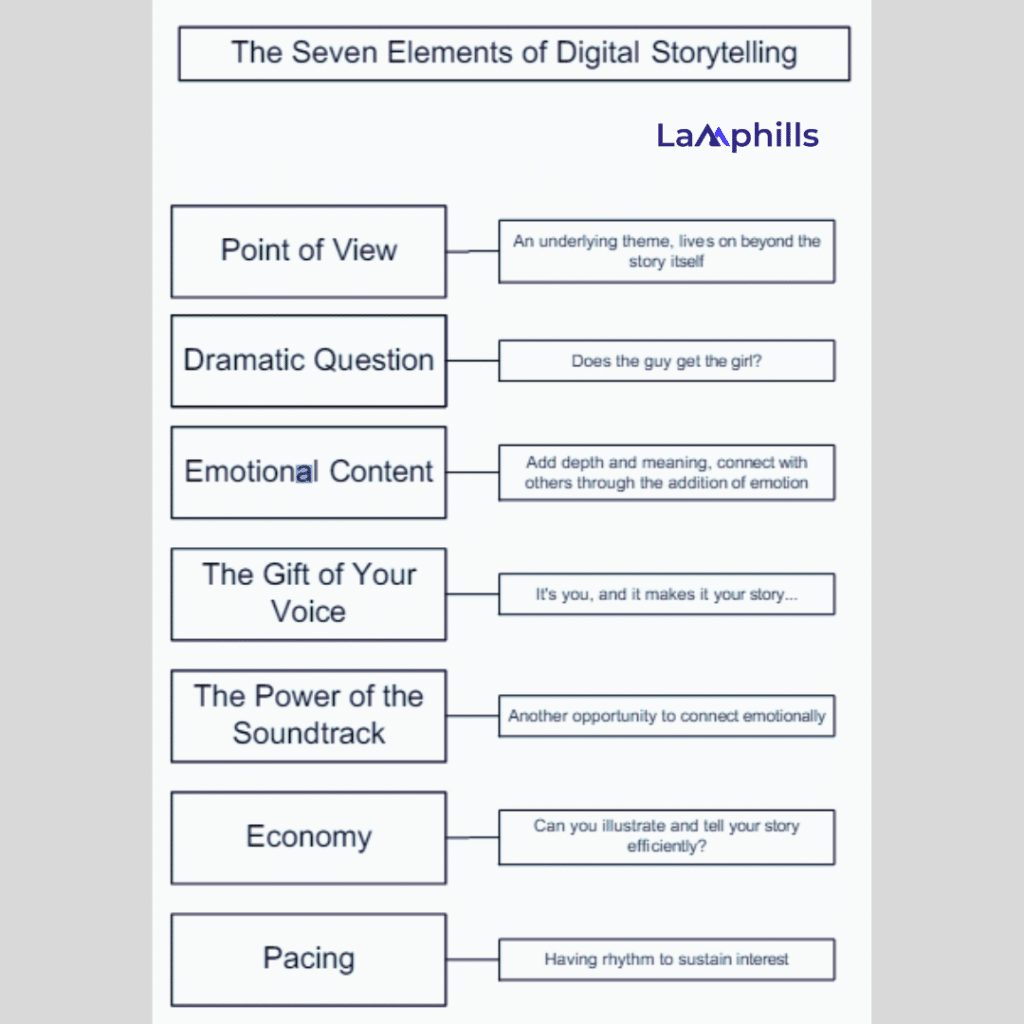Storytelling is a way humans have used to entertain, educate, and express their beliefs throughout history. The introduction of digital technology brought about a significant change in the storytelling genre. There are many digital storytelling platforms available in digital media that enable storytellers to interact with their global audience.
In this post, I will give you 13 digital storytelling examples that will inspire you. However, before we get into our examples, let’s start with the fundamentals: What is digital storytelling?
Key Points
- Digital storytelling uses technology to reach larger audibce.
- It allows brands to tell their story without limits.
- It allows for creativity and innovation in storytelling.
- Platforms like TikTok and YouTube allow you to share your stories online.
- Digital storytelling has elements that make it easy for you to interact with your audience effectively.
What is Digital Storytelling?
Digital storytelling is the use of technology and all of its benefits to reach a large audience with your stories. It creates more interactive and interesting stories by combining words, images, sounds, and videos, as opposed to traditional approaches like books or oral tales.
Furthermore, digital storytelling is used to describe the method by which a variety of people tell others about their lives and imaginative fantasies. With the use of these modern technologies, people may now share their stories on the Internet via podcasts, TikTok, YouTube, and other electronic distribution platforms. Additionally, digital storytelling helps people establish their social media profiles and foster relationships as we will discover with the examples.
Read Also: The Top 10 Digital Marketing Agencies In Nigeria You Need to Know
What are the Benefits of Digital Storytelling?
Digital storytelling allows you, the storyteller, to completely control the story and how it is told. This is because it allows you to manipulate everything from the visuals to the narrative’s timing in order to give the audience an impactful experience. It allows you to tell the story from firsthand knowledge and an angle that the audience might not be familiar with.
Furthermore, social media platforms and websites like Facebook, TikTok, and YouTube make it simple to share your digital stories with others. This allows others to access knowledge about a subject without being physically present, like visiting a museum or attending an event.
Lastly, digital content may frequently be updated quickly when there is a piece of new information or a new viewpoint on an issue.
Types of Digital Storytelling
Here are the types of digital storytelling that you may consider to tell your story:
- GIFs and Memes
- Virtual Reality (VR) and Augmented Reality (AR)
- Podcasts
- Behind-the-Scenes Content
- Press Releases
- Videos (e.g., YouTube)
- Ebooks and audiobooks
- Images
- Advertisements
- Forums
- Social media posts (TikTok, Instagram posts, etc.)
- Blogs and articles
- Video games
Now let’s examine the elements of digital storytelling.
Read Also: How To Use Pinterest For Blogging: My Winning Strategy
What are the 7 Elements of Digital Storytelling?

#1. Point of View:
Using digital storytelling, you can share your own special and intimate story. Because it is subjective rather than objective, a “first-person” format works well for it. Like with any excellent story, your audience will be interested in hearing about something real that happened to you if you put yourself in the role of the storyteller and protagonist.
Therefore, you should use the first-person pronoun “I” instead of the more detached third-person point of view.
#2. A Dramatic Question:
A dramatic question holds the interest of the audience, and the answers are given at the end of the story. By asking these questions, you can build suspense and keep the audience interested until the conclusion.
Note that a compelling story is one that poses a dramatic question that is answered in the conclusion. It is an intriguing subject that piques the reader’s curiosity and inspires commitment.
#3. Emotional Content:
Digital stories that evoke strong emotions in the audience and are relatable are the most effective. Therefore, you should choose an underlying emotional theme, such as the tempo and tone of voice. Telling a narrative from the heart and adding feelings you have felt to make it seem real helps.
Note that the most successful digital tales make their viewers feel something. It makes the audience members laugh, cry, and express joy. For an author, this is satisfying as it validates their hard work and dedication.
#4. The Gift of Your Voice:
There’s no better way to communicate your story than with your own voice, even if you may not enjoy the way it sounds. By doing this, you will allow your audience to see a little bit of your personality, which will help them relate to you and what you have to say more readily.
To ensure that this does not seem artificial,
- You should take your time to memorize and rehearse your script.
- Make multiple recordings, attempting to maintain a conversational tone equivalent to having a coffee talk with a buddy.
A digital audio file has the advantage since you can combine different recordings to get the optimal sound.
#5. The Power of the Soundtrack:
Sound effects can add mood to a story. Music can improve a story and give visual imagery more emotional depth. However, it’s crucial to choose your background sound wisely because an excessive amount of audio can annoy or distract the listeners.
When selecting music, keep copyright restrictions in mind and only use third-party audio that doesn’t require a license. Many platforms, such as Creative Commons, provide music or sounds that are free of copyright restrictions. As an alternative, you can record your own voice or contact a friend who is a good musician or instrumentalist to assist you.
Note that when you use it well, music can improve the underlying narrative, bringing depth and complexity to the story.
#6. Economy:
Digital stories that are emotionally engaging and brief must make good use of word choice. Therefore, you must remove unnecessary details and concentrate on the details that share the main idea of the story.
#8. Pacing:
A hurried plot can overwhelm viewers, just as a glacial pace might tire them. Therefore, you should find a balance between image duration variations and the usage of pan and zoom effects when necessary to keep your audience’s interest.
Now lets go through the best digital storytelling examples that i have listed.
13 Digital Storytelling Examples that Will Inspire You
Here are the top digital storytelling examples that will inspire yours:
#1. The Skimm Easy reading
Skimm tries to make the news as concise, easy to read, and enjoyable as they can.
Who has the time to peruse the entire New York Times newspaper? The majority of us work far too much for that. The largest news articles of the day are therefore broken down into digestible information chunks by The Skimm and delivered straight to your email every morning. You can test this innovative, contemporary method of (news) storytelling by amassing a newsletter subscriber base.
#2. Spotify Wrapped
Spotify is one of the the top digital storytelling examples that gives excellent illustration of a successful digital story. They have a knack for drawing viewers in and captivating them with their digital story. People eagerly await the unveiling of their Spotify-wrapped playlists every year.
They played a game in 2023 and disclosed The Global Artist piece by piece (there were actually puzzles, or banners, hidden in various places).
Participants engaged with this digital narrative. As they awaited the big announcement, they banded together globally and began looking for hints.
Read Also: The Top Music PR Companies in 2024 Nigeria (Updated)
#3. Nike Brand Heroes
Nike is well-known for its incredibly effective marketing materials, which consistently reinforce the brand’s three main values—strength, grit, and perseverance—in every message. Nike’s brand storytelling uses the recommendations and needs of its clients to market its products.
For example, it frequently requests product endorsements from sportsmen and other celebrities. Nike’s products have the ability to reach a broad audience due to the large following of these influential personalities. Popular Nike athletes nowadays include Giannis Antetokounmpo, LeBron James, Michael Jordan, and others.
The brand’s narrative is centered around real-life heroes, who stand for perseverance and hard work. Nike’s marketing campaigns offer top digital storytelling examples.
Read Also: Brand Assets: 15 Examples That Will Strenghten Your Band
#4. Netflix Interactive Storytelling
With its “interactive” programming category, Netflix introduced this idea to the digital realm.
Do you want to choose the actions of your favorite TV character? Do you want to follow the story as it develops? You can choose what happens in the end with Netflix, and it’s a really interesting experience. Though ultimately subjective, it’s intriguing to see how platforms are using technology to tell tales in fresh and engaging ways.
Read Also: How Digital Technology Revolutionized My TV Viewing Experience
#5. Always #LikeAGirl Campaign
In 2014, Always launched the #LikeAGirl campaign, which challenged gender stereotypes.
This fantastic campaign revolved around a video that asked viewers of different ages and backgrounds to act in certain ways “like a girl.” It demonstrated how adolescence might affect how girls view their own potential.
The goal was to give girls of all ages a greater sense of confidence and to redefine what it meant to act “like a girl.” The #LikeAGirl hashtag generated a lot of conversation and was tweeted more than 4,000 times in a single day.
#6. Dove Men’s Care Program
Dove is another amazing brand that offers some valuable storytelling advice. Dove has revolutionized the art of storytelling by using a single emotion to unite people through its numerous global advertisements.
Launched on Father’s Day, its Men+Caring program strives to create a culture of caring for fathers and men in general. In addition to offering them a variety of resources to strengthen their bond with the business, the effort reflects the experiences of actual fathers.
#7. Apple “Detour”
Apple has consistently produced engaging advertisements and videos to make an impact. “Detour” is among Apple’s most outstanding storytelling pieces. This video tells the tale of a child who goes missing in a cycle. It travels on an exciting adventure before returning to its owner, the young child, in a cycle. The iPhone 7 Plus was used to record the entire advertisement. It was entertaining and intriguing for the audience to watch.
In addition to showcasing several iPhone 7 Plus features, the short film incorporates several French cinematic techniques, including underwater filming, time-lapse, animation, and slo-mo. This wonderful digital storytelling in this 11-minute film provides an entertaining story for the viewers to watch.
#8. Coca-Cola Augmented Reality Story
Coca-Cola made use of augmented reality (AR) to demonstrate that marketing storytelling can be executed successfully on a variety of platforms. Customers saw various storylines come to life when they aimed smartphone cameras at a Coke can.
These AR-driven stories are all focused around sharing a Coke and feature a conflict, an engaging main character or characters, and lighthearted dialogue. The real Coca-Cola can be used as a prop and a vehicle for telling customers marketing stories. Customers enjoyed it and found it humorous because they felt like they were a part of this animated enhancement.
#9. Airbnb’s “That’s Why We Airbnb” Campaign.
Airbnb goes beyond just being a site for individuals to list and book lodging; its tagline is “connecting people around the world.” Additionally, the brand invites customers to establish connections with other travelers via the site. People from many cultures who share living spaces might take advantage of this chance to interact with others and broaden their perspectives.
The “That’s Why We Airbnb” campaign created by Airbnb India included accounts of actual travel encounters. Airbnb used this storytelling to persuade Indian tourists that connections and a sense of belonging could be discovered wherever they traveled.
#10. Lego Rebuild the World Campaign
The LEGO Group’s Rebuild the World campaign on September 20, 2021, aims to recognize children as imaginative problem solvers.
The campaign’s centerpiece is a charming film that follows a knight’s adventure across a varied village as it comes together to overcome obstacles and make friends. The emphasis is on how playing with LEGO fosters creative problem-solving abilities and imparts valuable life values like effective communication and resilience.
Throughout the humorous images of the campaign, creative solutions made with LEGO bricks are displayed, showcasing the incredible power of playing together. It’s the kind of digital story that appeals to both adults and children!
#11. Disney and the Little Duckling.
Storytelling and Disney go hand in hand. The Disney commercial for Disneyland Paris, which tells the tale of a young duck who wants to be like Donald Duck after seeing his picture in a comic book, is among the most amazing examples of Disney’s narrative in an advertisement.
Finally, this little duckling meets Donald Duck when it finally gets to Disneyland after a very difficult voyage. This little advertisement has a really moving quality that will connect with every viewer on an emotional level. It is heartfelt, elegant, and lovely. Above all, though, it’s a superb illustration of a nice narrative with a satisfying resolution.
#12. Instagram #HereForYou Campaign
Instagram’s #HereForYou mental health support campaign was introduced in 2017. There’s a video in it where Instagram users talk about their problems, such as depression or eating disorders.
It demonstrated how this social media platform assisted them in getting back on track, with the community playing a significant part. The hashtags #MentalHealthMatters, #RecoveryIsPossible, and #EndTheStigma are among those frequently used in discussions of mental health issues, and they are emphasized in this video. These digital storytelling examples or campaigns propel positive change in the society.
#13. Huggies No Baby Unhugged Campaign
Huggies, a well-known diaper brand around the world, reemphasized its mission of giving moms hugs in order to win them over emotionally. It produced the “No Baby Unhugged” campaign. Huggies told the world the tale of the transformative power of hugs through this advertisement.
The ad, which showed a mother holding her infant, reached the emotions of the audience. As a result, hospitals began to advertise Huggies diapers, spreading the word that these would be the best alternative to diapers and the ideal present for a mother to give her child.
Adding this insight from Huggies’ brand storytelling to the collection of the most effective storytelling pointers shows that you can reach your audience about your goods with an engaging story. Leverage the power of storytelling and emotionally convince the audience.
Now that you are inspired by the digital storytelling examples, let’s look at the steps to creating your own digital story.
Checkout this Digital Storytelling Checklist:
What are the Eight Steps to Digital Storytelling?
Now, let’s dive into the seven steps to creating digital storytelling.
#1. Begin with an idea.
Ideas are the foundation of all stories, and digital stories are no different. The idea can be a true life story or fiction. Create a proposal, write a paragraph, make a mental map, or use any other pre-writing method to help bring your idea to life.
Read Also: The Best 2024 PR Package Ideas & Everything You Need.
#2. Do your research and learn.
To create a solid knowledge base for your digital story, whether fictional or nonfiction, you’ll need to research, examine, or educate yourself on the subject. You will discover more information as you delve deeper into a subject.
Furthermore, the organization is crucial. You should use a mind map to organize your knowledge, which might be beneficial. Additionally useful are online note-taking tools, index cards, and outline formats. Organizing your data digitally will make the following steps much simpler.
Read Also: Top 10 Keyword Research Services in 2024
#3. Put it down in writing.
Writing a solid script is just the first step in telling a great story. I advise that you use the two pre-writing procedures mentioned above. With a small adjustment, a proposal you have could become an introduction. The main body of the work should fit together like a puzzle if the subject matter has been thoroughly studied and explored. All that’s needed is to fit the already-present components together.
Read Also: How To Write In AP Style Writing: The Ultimate Guide
#4. Create a storyboard or plan.
We start to move toward visual media literacy at this time. Storyboarding is the initial stage of fusing music and visuals. It is the plan or approach that will direct your image, video, and wise choices. Simple storyboards just have the script and any pictures or videos. You may add elements like background music and transitions.
#5. Compile and Produce Audio, Video, and Image Content
This is where you make your writing come to life. You may use your storyboard as a guide to collect or create images, music, and videos. Everything you choose will shape and define the tone of your digital narrative.
#6. Combine everything.
When you bring everything together, you’ll discover whether your storyline has to be adjusted or whether you have enough “material” for your story. You’ll discover that you need to go back and edit your storyboard.
#7. Share your story.
It is now possible for the world to see your story. You can use the Internet to share your story on platforms like YouTube or Instagram.
#8. Reflection and Feedback
Here you will ask: What did I discover? How can I improve the following time?
Therefore, you should evaluate your work and provide constructive criticism. At this point, you can benefit from the use of blogs and polling tools to get feedback from the public.
How do I start digital storytelling?
To start digital storytelling, you can follow the steps below, as outlined above:
- Create the idea.
- Research and learn.
- Write your story.
- Create a storyboard and plan what you want your story to look like.
- Gather or create images, videos, and audio.
- Put it all together.
- Share your story.
- Get feedback and reflect on how you can improve your story.
Related Articles:
Is Communications a Good Major? All You Need To Know
Building Bridges with International PR (My Journey to Global Brand Storytelling)
Video Storytelling: Its Benefits to Your Brand





